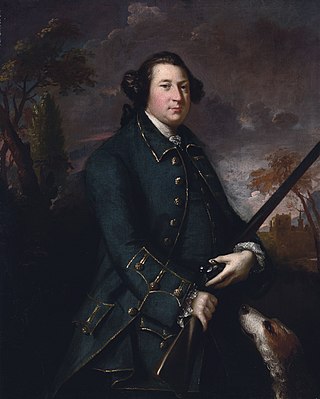
Earl of Roden is a title in the Peerage of Ireland. It was created in 1771 for Robert Jocelyn, 2nd Viscount Jocelyn. This branch of the Jocelyn family descends from the 1st Viscount, prominent Irish lawyer and politician Robert Jocelyn, the son of Thomas Jocelyn, third son of Sir Robert Jocelyn, 1st Baronet, of Hyde Hall. He notably served as the Lord Chancellor of Ireland from 1739 to 1756. In 1743, he was raised to the Peerage of Ireland as Baron Newport, of Newport, and in 1755 he was further honoured, when he was made Viscount Jocelyn, also in the Peerage of Ireland. He was succeeded by his son, the second Viscount. He represented Old Leighlin in the Irish House of Commons and served as Auditor-General of Ireland. In 1770 he also succeeded his first cousin once removed as fifth Baronet of Hyde Hall. In 1771 he was created Earl of Roden, of High Roding in the County of Tipperary, in the Peerage of Ireland. Lord Roden married Lady Anne Hamilton, daughter of James Hamilton, 1st Earl of Clanbrassil and sister of James Hamilton, 2nd Earl of Clanbrassil, a title which became extinct in 1798.

Baron Langford, of Summerhill in the County of Meath, is a title in the Peerage of Ireland. It was created on 1 July 1800 for Clotworthy Rowley, who had earlier represented Trim and County Meath in the Irish House of Commons. Born Clotworthy Taylor, he was the fourth son of Thomas Taylor, 1st Earl of Bective and Jane Rowley, daughter of Hercules Langford Rowley and his wife Elizabeth Rowley, 1st Viscountess Langford. The viscountcy of Langford became extinct in 1796 on the death of Hercules Rowley, 2nd Viscount Langford. Clotworthy Taylor succeeded to the Rowley estates and assumed by Royal licence the surname of Rowley in lieu of Taylor. Four years later the Langford title was revived when he was raised to the Peerage of Ireland as Baron Langford.
Nathaniel Clements, 2nd Earl of Leitrim, KP PC (Ire), styled The Honourable from 1783 to 1795, and then Viscount Clements to 1804, was an Irish nobleman and politician.

John Foster, 1st Baron Oriel PC (Ire) was an Anglo-Irish peer and politician, who served as Chancellor of the Exchequer of Ireland and as the last Speaker of the Irish House of Commons (1785–1800).

John Clotworthy, 1st Viscount Massereene was a prominent Anglo-Irish politician.
This is a list of people who have served as Lord Lieutenant of Louth.

John David Clotworthy Whyte-Melville Foster Skeffington, 14th Viscount Massereene and 7th Viscount Ferrard is a British peer.
John Clotworthy Talbot Foster Whyte-Melville-Skeffington, 13th Viscount Massereene and 6th Viscount Ferrard DL was a British politician and landowner. He was also Baron of Loughneagh, 6th Baron Oriel, and 6th Baron Oriel, and served as a Deputy Lieutenant for County Antrim. He succeeded his father in 1956 and regularly attended the House of Lords.
Viscount Langford, of Longford Lodge, was a title in the Peerage of Ireland. It was created on 19 February 1766 for Elizabeth Rowley. She was made Baroness of Summerhill at the same time, also in the Peerage of Ireland. She was the wife of Hercules Langford Rowley, a member of the Irish Privy Council, grandson of Sir John Rowley and Mary, daughter of Sir Hercules Langford, 1st Baronet. She was succeeded by her son, the second Viscount. He represented County Antrim and Downpatrick in the Irish Parliament. The title became extinct in 1796 on the death of the second Viscount. The Rowley estates were inherited by Clotworthy Taylor, fourth son of Thomas Taylor, 1st Earl of Bective by his wife Jane, daughter of Hercules Langford Rowley and the Viscountess Langford. He assumed by Royal licence the surname of Rowley in 1796 and in 1800 the Langford title was revived when he was raised to the Peerage of Ireland as Baron Langford. This title is still extant.
James Stevenson Blackwood, 2nd Baron Dufferin and Claneboye, styled as Sir James Blackwood, 3rd Baronet, from 1799 to 1807, was an Anglo-Irish peer and politician.
John Foster-Skeffington, 10th Viscount Massereene KP was an Irish peer and poet.
Thomas Henry Skeffington, 2nd Viscount Ferrard, styled The Honourable from 1790 until 1824, was an Irish peer and politician.
Algernon William John Clotworthy Skeffington, 12th Viscount Massereene and 5th Viscount Ferrard, DSO was British Army officer and an Ulster Unionist member of the Senate of Northern Ireland from 1921 to 1929. During this period he served as Deputy Leader of the Senate and Parliamentary Secretary in the Department of the Prime Minister.
Following the enactment of the House of Lords Act 1999, the number of hereditary peers entitled to sit in the House of Lords was reduced to ninety-two. Ninety of the first ninety-two were elected by all the hereditary peers before the passing of the reform. Since November 2002, by-elections have been held to fill vacancies left by deaths, resignations or disqualifications of those peers. Since the passing of the House of Lords Reform Act 2014, by-elections have also been held to fill vacancies left by the retirements of those peers.
The Custos Rotulorum of Londonderry and Down was the highest civil officer in counties Londonderry and Down.

Clotworthy Skeffington, 1st Earl of Massereene PC (I) was an Anglo-Irish peer.
Clotworthy Skeffington, 4th Viscount Massereene was an Anglo-Irish politician and peer.
Clotworthy John Eyre Skeffington, 11th Viscount Massereene was an Anglo-Irish peer.
Hercules Langford Rowley PC was an Irish politician and landowner.
John Skeffington, 2nd Viscount Massereene was an Anglo-Irish politician, official, and peer. He was one of the leading Presbyterians in Ireland during his lifetime.









